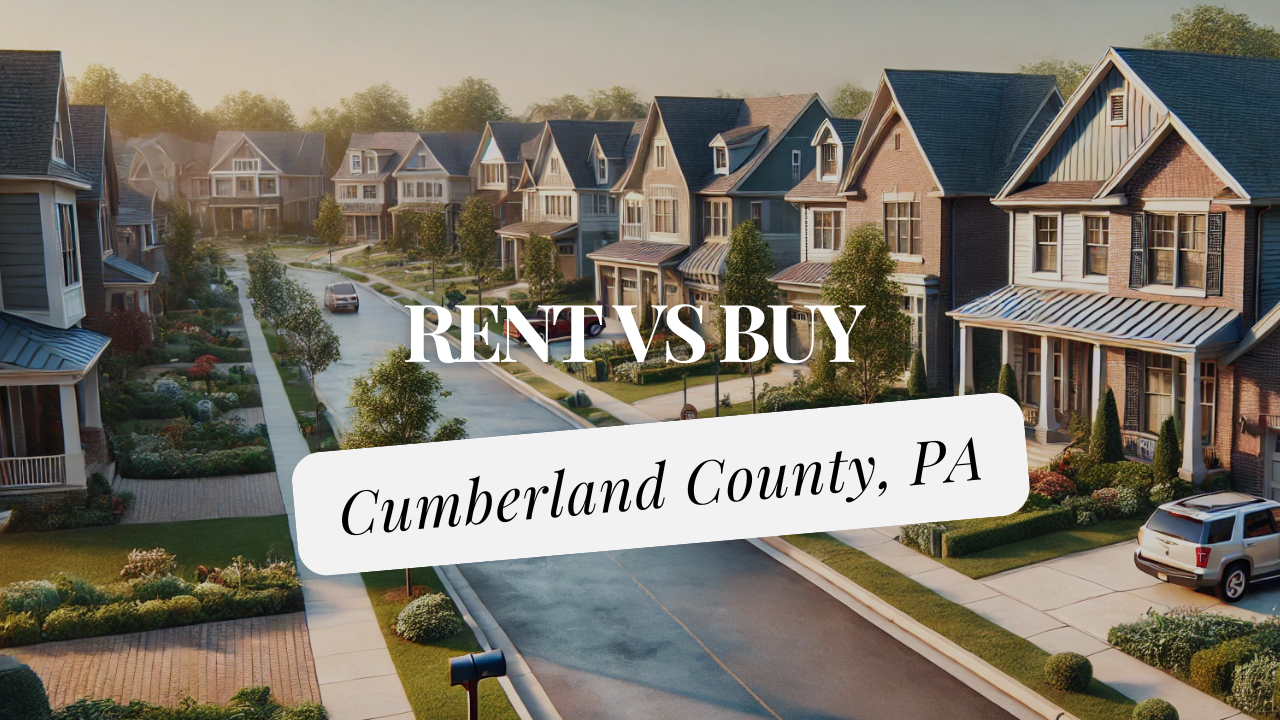Renting vs. Buying in Cumberland County, PA

When considering a home in Cumberland County, PA, individuals face a pivotal decision: renting or buying. A thorough financial analysis, grounded in local market trends and neighborhood specifics, reveals the best option for various lifestyles and budgets. This decision can significantly impact one’s finances, quality of life, and long-term investment strategy.
The real estate landscape in Cumberland County is evolving, with home prices experiencing steady growth. Understanding the nuances of renting versus buying in different neighborhoods allows potential residents to make informed choices. Factors such as median home prices and rental rates play crucial roles in this analysis, as they provide insight into the financial implications of each option.
Exploring the pros and cons of both renting and buying in specific areas gives individuals the tools to align their housing choices with their financial goals. Prospective occupants can uncover unique opportunities tailored to their needs, whether they are seeking stability through home ownership or flexibility through renting.
Key Takeaways
- Renting and buying have distinct financial implications in Cumberland County.
- Neighborhood profiles can significantly influence housing decisions.
- Current market trends indicate steady growth in home values.
Overview of Cumberland County, PA Real Estate Market
Cumberland County’s real estate market is currently experiencing a positive trend. As of February 2025, the median home sale price reached $313,275, reflecting a 4.4% increase from the previous year.
Key Statistics
- Average home value: $316,696
- Median listing price: $389,900, marking a 13% year-over-year increase
- Median price per square foot: $172
In January 2025, home prices in the county were up 14.2% compared to the previous year, with homes selling for a median price of $330,000.
Market Dynamics
The increase in home values indicates a competitive market. Several factors contribute to this trend, including low inventory and rising demand.
Many prospective buyers are evaluating their options between renting and buying. Understanding the financial implications in various neighborhoods can provide valuable insights for making informed decisions.
The market’s strength suggests potential benefits for investors and first-time buyers alike. They may find opportunities in a changing landscape, with neighborhood dynamics influencing individual experiences and investment outcomes.
Renting in Cumberland County: Pros and Cons
Renting in Cumberland County offers both opportunities and challenges. Understanding these factors is crucial for anyone considering this housing option.
Advantages of Renting
Renting provides flexibility, which is particularly valuable for those who may need to relocate for work or personal reasons. Tenants can typically sign short-term leases, allowing them to avoid long-term commitments.
Additionally, renters are not responsible for significant maintenance costs. Landlords usually cover repairs, enabling individuals to allocate their financial resources elsewhere. This is beneficial in a market where housing costs and living expenses can be high.
Cost-effective options: Renting may also be more affordable initially. For instance, the hourly wage required to afford a modest 2-bedroom home in Cumberland County is approximately $18.79, indicating that renting can be within reach for many.
Disadvantages of Renting
One notable downside of renting is the lack of equity accumulation. Payments made for rent do not contribute to ownership, meaning tenants may not benefit financially in the long term.
Another challenge is the potential for increasing rental rates. As demand for housing rises in Cumberland County, rents can increase, putting financial pressure on tenants.
Limited control: Besides financial considerations, renters often face restrictions on property modifications. Tenants may need permission to make alterations, which can be limiting.
Lastly, while renting provides flexibility, it may not offer the same sense of stability or community that homeownership does. These factors all play a significant role in the decision-making process for prospective renters.
Buying in Cumberland County: Pros and Cons
Buying property in Cumberland County offers distinct advantages and some drawbacks that potential homeowners should consider. The financial implications, long-term commitments, and the local real estate market dynamics play critical roles in the decision-making process.
Advantages of Buying
Purchasing a home can provide several significant benefits. One primary advantage is stability. Owning a property allows individuals to establish roots in a community, which can be appealing for families or those seeking long-term residence.
Equity Building: As mortgage payments are made, homeowners build equity. This equity can be a valuable asset over time. Unlike renting, monthly payments contribute to ownership rather than merely covering a landlord’s expenses.
Customization: Homeownership allows individuals to personalize their living spaces without restrictions. Owners can renovate or decorate according to their preferences, fostering a sense of pride in ownership.
Another consideration is the potential for rental income. For buyers interested in investment, properties can generate cash flow, particularly as demand for rentals increases in certain neighborhoods.
Disadvantages of Buying
Despite these advantages, there are notable disadvantages to consider. One of the primary concerns is financial commitment. Buying a home involves upfront costs, including down payments, closing costs, and ongoing maintenance expenses.
Market Risk: Real estate markets can fluctuate. A downturn in market conditions could lead to decreased property values, impacting the homeowner’s investment negatively.
Less Flexibility: Homeownership often ties individuals to a specific location. This can limit options if personal circumstances change, such as job relocation or family needs.
Additionally, homeowners are responsible for all maintenance and repairs, which can add unexpected costs and time commitment that renters do not face.
Comparative Financial Analysis
A detailed financial analysis reveals the nuances between renting and buying in Cumberland County, PA. This section explores the initial costs, ongoing expenses, and long-term financial projections associated with each option.
Initial Costs Comparison
When purchasing a home, initial costs encompass the down payment, closing costs, and moving expenses. The average home price in Cumberland County is approximately $313,275. A typical down payment could range from 3% to 20%, causing initial cash outlays to vary widely.
Example Costs:
- Down Payment (15%): $46,996
- Closing Costs: $6,000 – $9,000
Renters, on the other hand, face lesser initial costs. Security deposits often range from one to two months’ rent. For a property renting around $1,500 per month, this could mean an upfront cost of approximately $3,000.
Ongoing Costs Comparison
Ongoing costs greatly differ between renting and owning. Homeowners incur monthly mortgage payments, property taxes, homeowners’ insurance, and maintenance expenses.
Typical Monthly Costs for Homeowners:
- Mortgage Payment: $1,500
- Property Taxes: $300
- Insurance: $100
Renters pay monthly rent, which typically includes some utilities. For the same $1,500 rental property, utilities might total an additional $200.
Typical Monthly Rent Costs:
- Rent: $1,500
- Utilities: $200
Homeowners must also budget for unexpected maintenance, which varies based on property age and condition.
Long-term Financial Projection
Renting often means no equity buildup, while owning a home generally allows for appreciation. Given a 4.4% increase in home values in Cumberland County, homeowners might see significant equity growth over time.
Investing in a home may also provide tax benefits, such as mortgage interest deductions. For example, a mortgage interest payment of $10,000 annually can lower taxable income significantly.
Projected Growth:
- Home Value After 10 Years (4.4% Growth): $466,496
- Total Mortgage Paid: $180,000
Renters may find stability in housing but forfeit long-term financial gains. Understanding these financial dynamics can better inform the decision of whether to rent or buy in Cumberland County.
Neighborhood Profiles
Exploring the rental and buying landscape in Cumberland County reveals distinct characteristics across various neighborhoods. Each area presents its own financial dynamics and living conditions.
Carlisle: Renting vs. Buying
Carlisle offers a blend of historic charm and modern amenities which attracts families and professionals alike. The median home price stands at approximately $300,000, while average rent ranges between $1,200 to $1,600 for a two-bedroom unit.
Renting is appealing in Carlisle due to shorter commitments and no maintenance responsibilities. Buyers, however, benefit from appreciating property values and tax advantages. The neighborhood’s vibrant community and proximity to downtown enhance its desirability, making either choice a viable option depending on individual circumstances.
Camp Hill: Renting vs. Buying
Camp Hill is known for its excellent schools and bustling commercial areas. Housing prices are typically higher here, with median home values around $350,000. Renting costs for comparable properties can reach $1,700 monthly.
The rental market appeals to those who prefer flexibility, especially younger renters or professionals. On the other hand, purchasing property offers long-term investment potential given the area’s continued growth and family-friendly environment. Buyers may find this location ideal for raising children due to local amenities.
Mechanicsburg: Renting vs. Buying
Mechanicsburg presents a strong community-oriented environment. With a median home price of about $320,000, it remains an affordable choice relative to its neighbors. Renters might expect to pay between $1,300 to $1,800 in this area for similar accommodations.
Renting is great for those seeking to test the waters of Mechanicsburg’s community. Buyers benefit from a stable housing market and potential appreciation in property values due to ongoing development and infrastructure improvements. Thus, Mechanicsburg offers diverse options catering to various lifestyle choices.
Shippensburg: Renting vs. Buying
Shippensburg, recognized for its college-town atmosphere, provides affordable housing options. The median home price here is approximately $250,000, making it accessible for first-time buyers. Monthly rents typically range from $1,000 to $1,400.
Investors may find Shippensburg appealing due to its student rental demand. Renting offers the flexibility sought by many young professionals and students. Buyers can capitalize on potential rent income or enjoy a lower cost of living, further motivating them to consider purchasing a home.
Enola: Renting vs. Buying
Enola delivers a suburban feel with easy access to Harrisburg. The median home price is approximately $275,000, while rents for similar properties are generally between $1,100 and $1,500.
This neighborhood is favorable for families and commuters. Renting is attractive for those prioritizing mobility across the region. Buyers may appreciate less competitive pricing compared to nearby urban centers, alongside the long-term benefits of homeownership and stable community ties.
Economic Factors Influencing Renting and Buying
Several economic factors influence the decision to rent or buy property in Cumberland County.
Market Conditions
Housing supply and demand play a crucial role. When demand exceeds supply, prices typically rise, favoring sellers. Conversely, an oversupply can lead to lower home prices, making buying more attractive.
Interest Rates
Interest rates significantly affect mortgage costs. Lower rates reduce monthly payments, making homeownership more affordable. In contrast, rising rates can increase rental demand as potential buyers delay purchases.
Local Income Levels
The income levels of residents influence their ability to buy homes. Areas with higher incomes typically see more homeowners, while regions with lower income may have a higher percentage of renters.
Rental Rates
Current median rents in Mechanicsburg are around $902. Comparatively, the state and national averages are slightly higher. If rental prices increase faster than wages, renting may become less viable for many.
Economic Growth
Employment opportunities contribute to housing decisions. A growing job market encourages home buying, whereas economic downturns might lead to increased renting as individuals seek flexibility.
Government Policies
Local policies and incentives for first-time homebuyers can sway decisions. Programs offering financial assistance may encourage buying, while stricter lending practices can prompt renters to remain in the market.
Legal Considerations for Tenants and Homebuyers
When considering renting or buying a property in Cumberland County, it is crucial to understand the legal landscape.
Tenants’ Rights
Tenants are protected by the Pennsylvania Landlord-Tenant Law. Key rights include:
- Habitability: Properties must meet basic living standards.
- Security Deposits: Limits typically apply to how much landlords can charge.
- Notice Period: Tenants must receive appropriate notice for lease termination.
Homebuyers’ Legal Duties
Homebuyers should note several legal responsibilities, including:
- Title Search: Ensures there are no liens or claims against the property.
- Disclosures: Sellers must disclose known issues. This includes past damages or repairs.
- Zoning Laws: Buyers need to verify zoning regulations that could affect property use.
Lease Agreements
Both tenants and homebuyers encounter contractual agreements. Key elements to review are:
- Lease Terms: Duration, rent amount, and responsibilities for maintenance.
- Default Conditions: Understand what constitutes a breach of the contract.
Local Regulations
Cumberland County also has local ordinances affecting rentals and real estate transactions. Staying informed about these guidelines can prevent legal challenges.
Understanding these legal considerations helps ensure smooth transactions for both tenants and homebuyers in Cumberland County.
Market Trends and Future Outlook
Cumberland County’s housing market is currently experiencing significant changes. As of February 2025, the median home sold price reached $313,275, reflecting a 4.4% increase from the previous year. This upward trend suggests a growing demand for homes in the area.
Average home values align closely, with a reported value of $316,696, showing a similar increase of 4.5%. This stability indicates consistent market interest despite broader economic factors.
Recent data indicates a more pronounced increase in certain price ranges. For instance, home prices surged 14.2% in January 2025, with a median price of $330,000. This spike could attract both investors and new buyers looking for residential properties.
Key Factors Influencing the Market:
- Increased Demand: Population growth and local employment opportunities contribute to higher demand.
- Interest Rates: Fluctuations in mortgage rates can impact buying power, influencing whether individuals choose to rent or buy.
- Neighborhood Variability: Different neighborhoods within Cumberland County reflect varied market dynamics, necessitating localized analysis.
Future projections suggest that as demand continues, prices may stabilize or increase further, leading to more diverse housing options. Monitoring these trends will remain essential for potential buyers and renters in making informed decisions.
Conclusion and Recommendations
Renting and buying in Cumberland County presents distinct financial implications. Each option has its own set of benefits and challenges that individuals must evaluate based on their circumstances.
Key Considerations:
- Market Trends: The current housing market shows a median home price of approximately $313,275, reflecting a 4.4% increase since last year. This may impact buying decisions, especially for first-time homebuyers.
- Equity vs. Flexibility: Purchasing a home allows individuals to build equity but may limit flexibility. Renting provides mobility but does not offer long-term financial gains.
- Neighborhood Variability: Different neighborhoods within Cumberland County may have varying rental and purchase costs. A thorough comparison is essential.
Recommendations:
- Evaluate Personal Finances: Individuals should assess their financial readiness for a down payment and ongoing homeownership costs.
- Consider Length of Stay: Those planning to stay long-term may benefit more from buying, while those seeking flexibility might opt for renting.
- Consult Local Experts: Engaging with real estate professionals can provide insights tailored to specific neighborhoods and personal situations.
With careful analysis of these factors, individuals can make informed decisions that align with their financial goals.
Frequently Asked Questions
This section addresses common inquiries regarding the financial aspects of renting versus buying a home in Cumberland County, PA. Insights will cover long-term implications, neighborhood variations, factors affecting the real estate market, and specific steps for financial analysis.
What are the long-term financial implications of renting versus buying a home in Cumberland County, PA?
Renting provides flexibility but does not build equity. Buying facilitates homeownership, allowing individuals to create long-term wealth through property appreciation. Understanding how these dynamics play out in Cumberland County is essential for financial planning.
How does the initial investment comparison between renting and buying vary by neighborhood in Cumberland County, PA?
Initial costs differ across neighborhoods. For instance, more affluent areas may require larger down payments, while less expensive neighborhoods may offer more affordable entry points. Analyzing local market conditions helps potential buyers assess where their investment will yield the best returns.
What factors should be considered when analyzing the local real estate market for investment opportunities in Cumberland County, PA?
Several elements are crucial for evaluation. Factors like local economic conditions, job growth, and school district quality can influence property values. Additionally, current rental demand and the presence of amenities should be taken into account for informed investment decisions.
Can you outline the steps involved in performing a neighborhood-specific financial analysis for renting and buying in Cumberland County, PA?
Conducting this analysis requires a systematic approach. Start with gathering data on average home prices and rental rates in the neighborhood. Next, calculate the total cost of ownership, including mortgage rates and property taxes, then compare it to rental costs over a similar timeframe.
What are the tax implications for homeowners versus renters in Cumberland County, PA?
Homeowners may benefit from tax deductions, particularly mortgage interest and property taxes. Renters do not receive similar tax benefits but can sometimes claim deductions based on their rental expenses, depending on specific circumstances. Understanding these aspects can significantly affect financial outcomes.
How do rental yields in Cumberland County, PA compare to the potential appreciation of property values over time?
Current rental yields typically range between 6% to 8%, varying by neighborhood. On the other hand, property value appreciation in certain areas may exceed rental yields, making buying a more attractive option for long-term investment. Market trends should be monitored closely to inform decisions.

